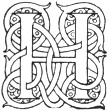
Masonic, Occult and Esoteric Online Library
Fictitious and Symbolic Creatures in Art
By John Vinycomb
Notes on Animated Beings in Heraldic Art - Introduction

"One chief source of illustration is to be found in the most brilliant, and in its power on character, hitherto the most effective of the Arts—HERALDRY."
Ruskin,
"Relation of Wise Art and Wise Science."
 HERALDRY is par excellence the science of symbols. A pictorial device is subject to no exact or regular law, provided it carries its meaning with it. Heraldry, on the contrary, insists on the observance of certain definite and easily understood rules constituting it a science, by the observance of which any one acquainted with heraldic language may, from a concise written description (or blazon as it is termed), reconstruct at any time the symbol or series of symbols intended, and with perfect accuracy; for a heraldic emblem once adopted remains unchangeable, no matter with what amount of naturalness or conventionality it may be done, or with what quaintness or even grotesqueness it may be treated; the symbol remains intact. "A lion rampant," "a dragon," or any other heraldic figure is, therefore, a fixed and immutable idea, and not to be confounded with any other, no matter what the style of artistic or decorative treatment it may receive.
HERALDRY is par excellence the science of symbols. A pictorial device is subject to no exact or regular law, provided it carries its meaning with it. Heraldry, on the contrary, insists on the observance of certain definite and easily understood rules constituting it a science, by the observance of which any one acquainted with heraldic language may, from a concise written description (or blazon as it is termed), reconstruct at any time the symbol or series of symbols intended, and with perfect accuracy; for a heraldic emblem once adopted remains unchangeable, no matter with what amount of naturalness or conventionality it may be done, or with what quaintness or even grotesqueness it may be treated; the symbol remains intact. "A lion rampant," "a dragon," or any other heraldic figure is, therefore, a fixed and immutable idea, and not to be confounded with any other, no matter what the style of artistic or decorative treatment it may receive.
Notwithstanding the evident intention everywhere in heraldry to be symbolic, in attitude as well as in tinctures, we find the greatest errors and absurdities constantly perpetrated. To many it seems as if it was not considered essential to acquire a knowledge of the rudiments of the science. Heraldry is a living language, and when the attempt is made to express it without proper knowledge the result can only be unmitigated nonsense. By inattention to those principles which regulate the attitude, the tinctures, and the disposition of every part of an armorial achievement, discredit is brought upon the subject, which should fall upon the head of the ignorant designer alone. No matter what heraldic position of an animal may be blazoned (though it admits of only one interpretation), we find the most unwarrantable latitude frequently taken by otherwise skilful artists in depicting it. The designer becomes a law unto himself, and it is posed and treated in a way to suit the fancy of the moment. A lion is only a lion to him, and it is nothing more. To the true herald it is very much more. As a mild instance, see the unkind treatment meted out to the supporters of the Royal Arms. The lion and unicorn are both "rampant," and the head of the lion is turned towards the spectator (termed guardant). Not content to be represented in the regulation positions, they will be found depicted in most strange and fantastic attitudes not recognised in heraldry—not supporting or guarding the shield, which is their special function. At the head of the Times newspaper they are represented playing at hide and seek round the shield; elsewhere we see them capering and prancing, or we find them sitting, like begging dogs, as if ashamed of themselves and their vocation.
I may here quote from a most admirable work: "That the decorative beauty of heraldry, far from being that of form and colour alone, was also an imaginative one depending much on the symbolic meaning of its designs, there can be no doubt. . . . Early Christian Art was full of symbols, whose use and meaning were discussed in treatises from the second century onwards. By the eleventh it had become systemised and ranged under various heads,—Bestiaria for beasts, Volucaria for birds, and Lapidaria for stones. It permeated the whole life of the people in its religious uses, and entered romantically into the half-religious, half-mystical observances of chivalry, the very armour of the valiant knight being full of meanings which it was his duty to know." *
Footnotes
17:* "Decorative Heraldry," by G. W. Eve.
